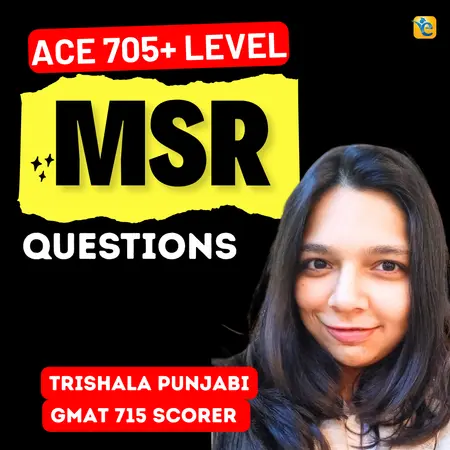Events & Promotions
|
|

GMAT Club Daily Prep
Thank you for using the timer - this advanced tool can estimate your performance and suggest more practice questions. We have subscribed you to Daily Prep Questions via email.
Customized
for You
Track
Your Progress
Practice
Pays
Not interested in getting valuable practice questions and articles delivered to your email? No problem, unsubscribe here.
- Nov 18
11:00 AM PST
-12:00 PM PST
Join us in a live GMAT practice session and solve 30 challenging GMAT questions with other test takers in timed conditions, covering GMAT Quant, Data Sufficiency, Data Insights, Reading Comprehension, and Critical Reasoning questions. - Nov 22
11:00 AM IST
-01:00 PM IST
Do RC/MSR passages scare you? e-GMAT is conducting a masterclass to help you learn – Learn effective reading strategies Tackle difficult RC & MSR with confidence Excel in timed test environment - Nov 23
11:00 AM IST
-01:00 PM IST
Attend this free GMAT Algebra Webinar and learn how to master the most challenging Inequalities and Absolute Value problems with ease. - Nov 25
10:00 AM EST
-11:00 AM EST
Prefer video-based learning? The Target Test Prep OnDemand course is a one-of-a-kind video masterclass featuring 400 hours of lecture-style teaching by Scott Woodbury-Stewart, founder of Target Test Prep and one of the most accomplished GMAT instructors.
Kudos
Bookmarks
C
Be sure to select an answer first to save it in the Error Log before revealing the correct answer (OA)!
Difficulty:
 95%
(hard)
95%
(hard)
Question Stats:
30% (02:50) correct 70%
(02:56)
wrong
70%
(02:56)
wrong  based on 591
sessions
based on 591
sessions
History
Date
Time
Result
Not Attempted Yet
Computer programs exist that attempt to generate random numbers, but no such program can fully replicate a truly random selection. Computer programs are, by definition, a set of instructions that use an input to generate an output. If both the input and the algorithm are known, the result is fully predictable. Even the best random number generation programs can only be called pseudo-random because the input itself is generated by the program. As a result, a pattern will emerge within the results, even if the program is sophisticated enough to make the pattern very complicated, and that pattern can be used to predict future results. True random number generation often depends on measurement of an unpredictable physical phenomenon, such as weather patterns or atmospheric radiation, and using that measurement as an input to generate a result.
The passage provides information sufficient to infer each of the following statements EXCEPT:
A The outputs of random number generators that provide their own input could, with enough information about past results, eventually be predicted.
B If a person knew both the algorithm that a corporation used to generate a truly random number and the atmospheric measurements that served as the input, the person would be able to generate the same output obtained by the corporation.
C With a sufficiently large table of the results of a pseudo-random number generator over time, it would be possible to derive the input and algorithm used to generate those results.
D The integrity of applications for which the unpredictability of the result is vital, such as lotteries or data encryption, can be best preserved by using a method of random number generation that is truly random.
E It is impossible to know the exact amount of atmospheric radiation emitted at a particular location and time until after a measurement is taken.
The passage provides information sufficient to infer each of the following statements EXCEPT:
A The outputs of random number generators that provide their own input could, with enough information about past results, eventually be predicted.
B If a person knew both the algorithm that a corporation used to generate a truly random number and the atmospheric measurements that served as the input, the person would be able to generate the same output obtained by the corporation.
C With a sufficiently large table of the results of a pseudo-random number generator over time, it would be possible to derive the input and algorithm used to generate those results.
D The integrity of applications for which the unpredictability of the result is vital, such as lotteries or data encryption, can be best preserved by using a method of random number generation that is truly random.
E It is impossible to know the exact amount of atmospheric radiation emitted at a particular location and time until after a measurement is taken.
Kudos
Bookmarks
A short summary of the given question stem is if you program is generating the input, is applying an algorithm and generating an output-> The results driven would be predictable from the patterns that would be seen in the output. With this thought, let's evaluate...
We need to pick a choice that doesn't follow this thought...
A The outputs of random number generators that provide their own input could, with enough information about past results, eventually be predicted. Direct conversion of the summary..
B If a person knew both the algorithm that a corporation used to generate a truly random number and the atmospheric measurements that served as the input, the person would be able to generate the same output obtained by the corporation.
This choice is adding that the program is not picking the input, nonetheless you know the input, there is an an algorithm, very easy to predict the result. OUT
C With a sufficiently large table of the results of a pseudo-random number generator over time, it would be possible to derive the input and algorithm used to generate those results.
Here we only know the results, we want to derive both the inputs and the algo.. Nope the argument never said this. KEEP
D The integrity of applications for which the unpredictability of the result is vital, such as lotteries or data encryption, can be best preserved by using a method of random number generation that is truly random.
This is an example of the application of a good random generator where the results cannot be predicted.
E It is impossible to know the exact amount of atmospheric radiation emitted at a particular location and time until after a measurement is taken.
The last statement in the QS talks about this..
I hope this helps.
------------------------------
Have faith in yourself.
We need to pick a choice that doesn't follow this thought...
A The outputs of random number generators that provide their own input could, with enough information about past results, eventually be predicted. Direct conversion of the summary..
B If a person knew both the algorithm that a corporation used to generate a truly random number and the atmospheric measurements that served as the input, the person would be able to generate the same output obtained by the corporation.
This choice is adding that the program is not picking the input, nonetheless you know the input, there is an an algorithm, very easy to predict the result. OUT
C With a sufficiently large table of the results of a pseudo-random number generator over time, it would be possible to derive the input and algorithm used to generate those results.
Here we only know the results, we want to derive both the inputs and the algo.. Nope the argument never said this. KEEP
D The integrity of applications for which the unpredictability of the result is vital, such as lotteries or data encryption, can be best preserved by using a method of random number generation that is truly random.
This is an example of the application of a good random generator where the results cannot be predicted.
E It is impossible to know the exact amount of atmospheric radiation emitted at a particular location and time until after a measurement is taken.
The last statement in the QS talks about this..
I hope this helps.
------------------------------
Have faith in yourself.
Kudos
Bookmarks
In option E, although author talks about it but in option E , word "impossible" is used, which is too extreme, while author uses the word "often" . Generally in CR questions, we don't prefer such options, right? Can someone please explain? However, i do agree that option 'C' is the best suited option.











